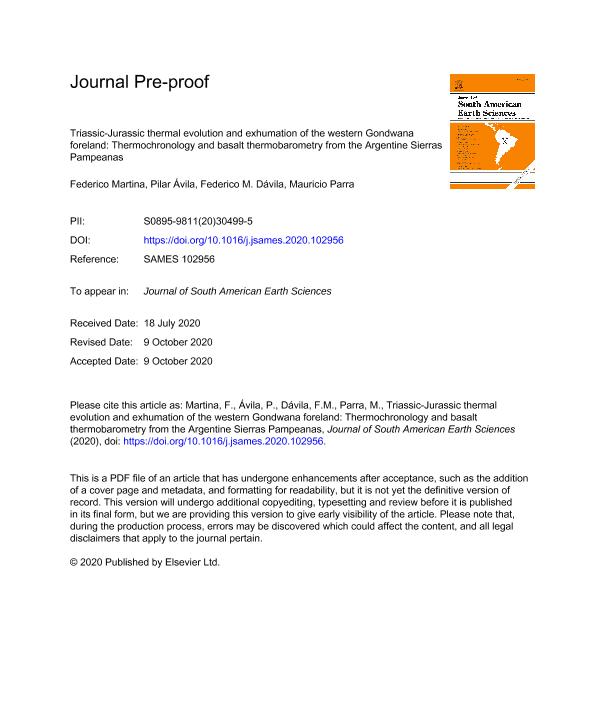Artículo
Triassic-Jurassic thermal evolution and exhumation of the western Gondwana foreland: Thermochronology and basalt thermobarometry from the Argentine Sierras Pampeanas
Fecha de publicación:
10/2020
Editorial:
Pergamon-Elsevier Science Ltd
Revista:
Journal of South American Earth Sciences
ISSN:
0895-9811
Idioma:
Inglés
Tipo de recurso:
Artículo publicado
Clasificación temática:
Resumen
The geological record of the eastern Sierras Pampeanas province, in the modern Andean broken foreland of Argentina can be divided into four main events: (1) Proterozoic to early Paleozoic collisional tectonics, (2) middle-late Paleozoic anorogenic magmatism, relief generation and glacial paleovalley formation followed by (3) a classical foreland filling in the Permian and two proximal alluvial sedimentation associated with (3) Cretaceous rifting and (4) Neogene intermontane foreland accumulation. The region lacks Silurian, Triassic and Jurassic records, commonly associated with unknown deformation and/or no-sedimentation stages (bypass zone?). In this work, we analyzed the Mesozoic (Triassic-Jurassic) Pampean unconformity, using low- temperature thermochronological modelling. After a rapid Carboniferous cooling track, a Triassic reheating followed by a slow Jurassic to Cretaceous cooling. Considering that (1) no Triassic basins have been described to date in the eastern Sierras Pampeanas (i.e., reheating cannot be related to burial), (2) coeval surface heat flows are anomalously high in western Sierras Pampeanas, in the Ischigualasto basin, and (3) our petrogenetic modelling on Triassic basalts evidence mantle potential temperatures of ~1350-1400 °C (i.e., the heat source cannot be related with an anomalously high basal heat flows and/or mantle plumes); we interpreted the formation of the Mesozoic unconformity as a result of ridge collision and slab window formation, followed by slab rollback. Both processes might have affected not only the surface heat flow but also triggered a lithospheric thickness reduction, which drove isostatic rebound. In this context, the Jurassic history of the unconformity could be associated with cooling by erosion and exhumation until the Cretaceous, when the region was under extension. Our model agrees with other observations like the formation of back-arc hydrocarbon-productive Triassic-Jurassic depocenters to the west (Cuyo and Ischigualasto basins) and the magmatic evolution, from 28° to 34° SL, described along the Chilean margin.
Archivos asociados
Licencia
Identificadores
Colecciones
Articulos(CICTERRA)
Articulos de CENTRO DE INVEST.EN CS.DE LA TIERRA
Articulos de CENTRO DE INVEST.EN CS.DE LA TIERRA
Citación
Martina, Federico; Avila, Pilar; Davila, Federico Miguel; Parra, Mauricio; Triassic-Jurassic thermal evolution and exhumation of the western Gondwana foreland: Thermochronology and basalt thermobarometry from the Argentine Sierras Pampeanas; Pergamon-Elsevier Science Ltd; Journal of South American Earth Sciences; 105; 10-2020; 1-37
Compartir
Altmétricas




